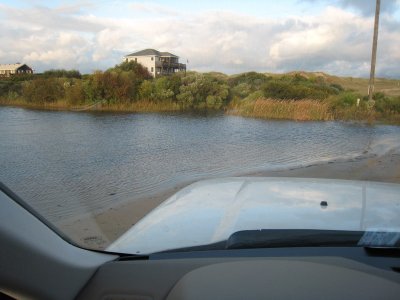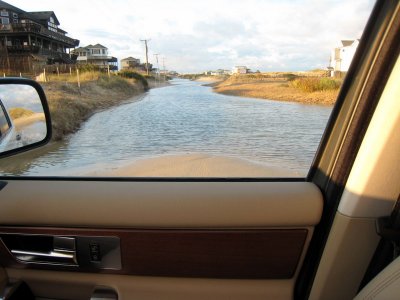Hey Folks,
I've been driving around in lots of sand roads behind the dunes in NC. Many of them are flooded at their lower points from a storm a few weeks ago. It's not salt water.
Anyways, I know the standard stuff about how to approach these by looking for familiar landmarks, trying to go on the outside, looking for other tire tracks that have gone through, gauging depth with a stick, etc. I'm not willing to actually wade thru the stuff yet So far I haven't found one that the car can't handle, but I feel like I'm going in too fast, in an attempt to ensure I dont get stuck in the middle.
So far I haven't found one that the car can't handle, but I feel like I'm going in too fast, in an attempt to ensure I dont get stuck in the middle.
What happens is I'll go down one of these (typically switching from hi range sand mode to low range mud/ruts) before. Then I go in slow and hit the gas and then the road really dips, my front end drops suddenly as it gets deeper (frequently causing a rush of water to come over the top of the hood (and into the car once as I had my back windows down - that was extra fun) accompanied by a little smoke from the water hitting the hot engine) and then I'll end up on the incline back out and that's when I breath out. It all feels a little too violent to me on the car. And really the water isn't that deep (maybe up to 16-20", it's just that it can get deep fast.
I haven't been able to watch other cars go through these nor have had any experience going through - but I just feel like I need to power through it and I'm thinking I should be going much slower.
I'm sort of answering my own question on this as I type, but I'll post it anyways. I should be going through the water more slow and steady versus 'all quick like just to get in and out fast'
I've been driving around in lots of sand roads behind the dunes in NC. Many of them are flooded at their lower points from a storm a few weeks ago. It's not salt water.
Anyways, I know the standard stuff about how to approach these by looking for familiar landmarks, trying to go on the outside, looking for other tire tracks that have gone through, gauging depth with a stick, etc. I'm not willing to actually wade thru the stuff yet
What happens is I'll go down one of these (typically switching from hi range sand mode to low range mud/ruts) before. Then I go in slow and hit the gas and then the road really dips, my front end drops suddenly as it gets deeper (frequently causing a rush of water to come over the top of the hood (and into the car once as I had my back windows down - that was extra fun) accompanied by a little smoke from the water hitting the hot engine) and then I'll end up on the incline back out and that's when I breath out. It all feels a little too violent to me on the car. And really the water isn't that deep (maybe up to 16-20", it's just that it can get deep fast.
I haven't been able to watch other cars go through these nor have had any experience going through - but I just feel like I need to power through it and I'm thinking I should be going much slower.
I'm sort of answering my own question on this as I type, but I'll post it anyways. I should be going through the water more slow and steady versus 'all quick like just to get in and out fast'




